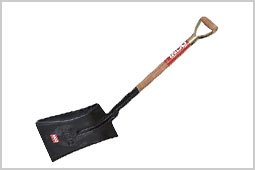
Digging shovels are designed to do just that. They feature a slightly curved spoon with upturned edges and a pointed (middle) or flat (left) tip. The pointed tips are generally used for digging and planting in soft, tilled soils, while the sharp, flat tips of the square tips are used more for tough, soils that require more force to penetrate. Square-nose shovels can also perform many of the same functions as garden shovels (right): tilling borders, transplanting shrubs and small trees, cutting grass and small roots, dividing plants, and ditching.
Look for shovels with steel spoons, as they are more durable than aluminium alternatives. Its handles are available in wood, composite or metal.
Features and operation
A common shovel can have a height with its handle of 1.0 m, a mass of 2.0 to 3.0 kg, a working width of 250 to 300 mm, a length of the shovel itself of 250 mm, and a thickness of 2 mm. However, there are many variations in the technical characteristics, depending on the manufacturer.
The worker buries the blade of the shovel in the ground (or other material), for which he can help himself by pressing with his foot or simply pushing with his hands. He tilts the handle, which dislodges the material, holds a part in the cavity of the blade, lifts and moves it, and then pours it wherever he wants.
What are the different types of shovel and their usages?
A shovel is a long-handled tool with a shovel blade. A large, industrial-strength shovel for moving grain or snow or cleaning is sometimes called a barn shovel. These blades typically have a flat leading edge and are remarkably deep, with high sides to stabilize the load.
- Garden shovels: differ from shovels in both construction and purpose. The shovel’s blade extends almost downward from the handle, making it suitable for working the land but not for lifting and moving it. Shovels, with the curved attachment, called a lift, between the blade and the handle, allow the user to leverage the load.
- Standard garden shovels: are round-nosed shovels with a blade approximately 8 inches wide and 12 inches long (20 x 30 cm). It is somewhat curved on the edge to help hold the load. Floral paddles are made to move a bit more delicately within a flower bed and are therefore smaller. Square-nose shovels, which have a flat bottom edge, are designed to pick up and lift loose material, not dig.
- Coal shovel: Coal shovels are available with shorter or longer handles.
- Snow shovel: Snow shovels can have metal or plastic blades, and the blades often have ridges. Some snow shovel blades are quite flat, while others have more curves from bottom to top. There are handle variations, such as T-shaped handles and curved handles designed to make them more ergonomically solid, and snow shovels designed to push snow as well as dig and lift it. Some of these latter types of shovels have U-shaped handles that are held in both hands.
- Oven Shovels: these are shovels with a flat and wide plate and a very long handle.
- Shovels With tip: It is curved and ends at a point, is intended to be inserted into materials with difficulty to be penetrated, as is the case of small stones (gravel), asphalt, earth, etc.
- Square shovels: Wide, flat-tipped scoop shovels are terrible for digging but great for moving loose materials like coal or stone (left), snow (middle), and grain (right). Those with steel spoons tend to be a bit heavier than the aluminum versions but are less likely to warp or warp over time.







